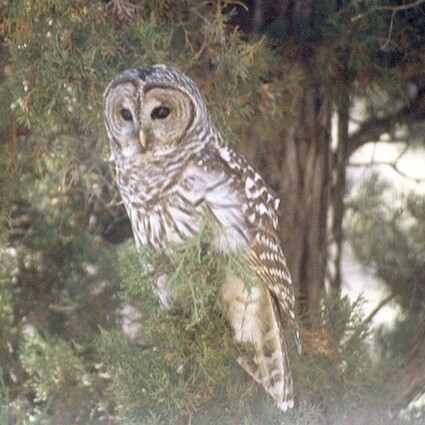The barred owl is here to stay
Last updated 12/23/2019 at Noon
First it was rumors, “The barred owls are coming, the barred owls are coming…” Next, it was the dire warnings that the barred owls were going to either chase all the northern spotted owls out of the Northwest, or breed with them and bring forth a whole new sub-species called “sparred owls.”
Then the warning was the feathered invader would compete with the spotted owls for prey and eat them out of house and home — which seems to be the case. In any event, the last I heard, Wildlife Services — the arm of the Federal Department of Agriculture that uses deadly force to solve wildlife problems — was assassinating barred owls in the Pacific Northwest.
Way back in the 1980s, one turned up in Alfalfa, and then about five years ago I found one spending some time in Tumalo State Park on the Deschutes River, and another was seen near Crescent, then recently another was observed hanging around the Old Mill District in Bend. And now they’re in Peggy Tehan’s backyard in Sisters, roaming around Tumalo and the countryside in between.
Unlike the spotted owl who is a specialist and concentrates feeding on small boreal rodents in old-growth forests— with an occasional gopher or two for variety — the barred will gobble up just about anything it can find, maybe even a chicken or two.
We humans have played a big role in allowing the barred owl to migrate from the east to the west. It is our logging practices that opened the gate. Clear-cutting became a way of life for the logging industry in the Northwest, and Canada enjoys that method of cutting trees as well. So we have created a forested freeway for them to travel.
Barred owls are mostly cavity nesters, which puts them in direct competition with our native screech, saw-whet and pygmy owls for breeding sites. The barred owl being the larger of the group means it may win that battle as well.
As far as I know, the barred owl is the ONLY owl that sings an eight-note call. I have heard birders humanize the call to, “Who cooks for you, who cooks for all,” with a drop in the tone on the last part. It’s normally pretty noisy in spring — but if a great horned owl responds to the barred’s call it will shut down immediately and may even leave the country. Great horned owls are the chief predator of barred owls.
Don’t be surprised if you’re out fly-fishing and you come upon a barred owl standing in the creek or edge of a lake. They will occasionally wade into water to gobble up a few spawning fish, pollywogs, frogs, salamanders or crayfish. Barred owls will even come to a campfire if it illuminates large insects, such as June bugs and the like.
If you ever find yourself back in Brooklyn, New York, take a few minutes and visit the art museum. John James Audubon’s original illustration of the barred owl stalking a gray squirrel — engraved and colored by Robert Havell’s London workshop — is on display there.
Anyway, keep your eyes peeled for an owl about the size of our local great horned, but without any “horns.” Don’t be bashful about sending me an email if you see one; I promise, I won’t shoot it or tell anyone from Wildlife Services where you live. And if it sings that eight-note song to you, consider yourself one of the lucky ones.

















Reader Comments(0)